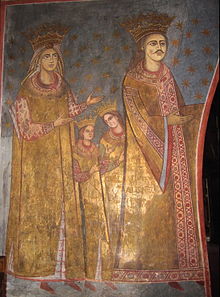
The 16th century began with the Julian year 1501 and ended with either the Julian or the Gregorian year 1600 (MDC), depending on the reckoning used.

Moldavia is a historical region and former principality in Central and Eastern Europe, corresponding to the territory between the Eastern Carpathians and the Dniester River. An initially independent and later autonomous state, it existed from the 14th century to 1859, when it united with Wallachia as the basis of the modern Romanian state; at various times, Moldavia included the regions of Bessarabia, all of Bukovina and Hertsa. The region of Pokuttya was also part of it for a period of time.

Wallachia or Walachia is a historical and geographical region of modern-day Romania. It is situated north of the Lower Danube and south of the Southern Carpathians. Wallachia was traditionally divided into two sections, Muntenia and Oltenia. Dobruja could sometimes be considered a third section due to its proximity and brief rule over it. Wallachia as a whole is sometimes referred to as Muntenia through identification with the larger of the two traditional sections.
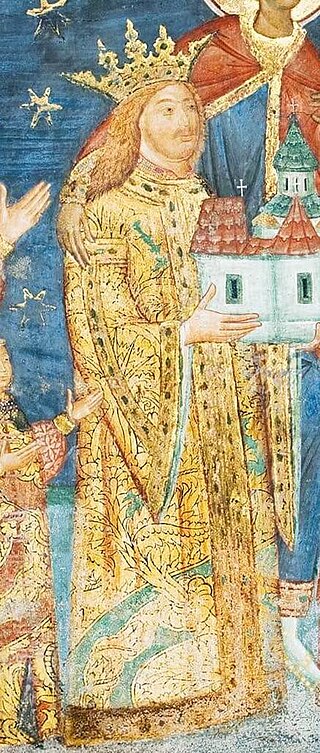
Stephen III, commonly known as Stephen the Great ; died 2 July 1504), was Voivode of Moldavia from 1457 to 1504. He was the son of and co-ruler with Bogdan II, who was murdered in 1451 in a conspiracy organized by his brother and Stephen's uncle Peter III Aaron, who took the throne. Stephen fled to Hungary, and later to Wallachia; with the support of Vlad III Țepeș, Voivode of Wallachia, he returned to Moldavia, forcing Aaron to seek refuge in Poland in the summer of 1457. Teoctist I, Metropolitan of Moldavia, anointed Stephen prince. He attacked Poland and prevented Casimir IV Jagiellon, King of Poland, from supporting Peter Aaron, but eventually acknowledged Casimir's suzerainty in 1459.

Radu III of Wallachia, commonly called Radu the Handsome, Radu the Fair, or Radu the Beautiful, was the younger brother of Vlad the Impaler and prince of the principality of Wallachia. They were both sons of Vlad II Dracul and his wife, Princess Cneajna of Moldavia. In addition to Vlad III, Radu also had two older siblings, Mircea II and Vlad Călugărul, both of whom would also briefly rule Wallachia.

Lupu Coci, known as Vasile Lupu, was a Voivode of Moldavia of Albanian and Greek origin between 1634 and 1653. Lupu had secured the Moldavian throne in 1634 after a series of complicated intrigues and managed to hold it for twenty years. Vasile was a capable administrator and a brilliant financier and was soon almost the richest man in the Christian East. His gifts to Ottoman leaders kept him on good terms with the Ottoman authorities.
The Moldavian Magnate Wars, or Moldavian Ventures, refer to the period at the end of the 16th century and the beginning of the 17th century when the magnates of the Polish–Lithuanian Commonwealth intervened in the affairs of Moldavia, clashing with the Habsburgs and the Ottoman Empire for domination and influence over the principality.
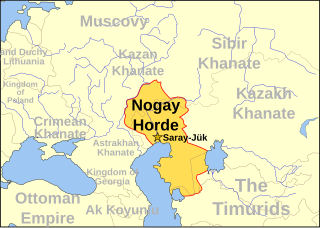
The Nogai Horde was a confederation founded by the Nogais that occupied the Pontic–Caspian steppe from about 1500 until they were pushed west by the Kalmyks and south by the Russians in the 17th century. The Mongol tribe called the Manghuds constituted a core of the Nogai Horde.
The names of Moldavia and Moldova originate from the historical state of Moldavia, which at its greatest extent included eastern Romania, Moldova, and parts of south-western and western Ukraine.
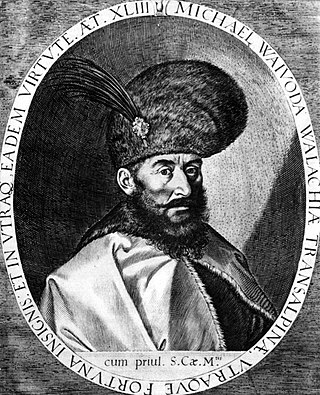
Michael the Brave, born as Mihai Pătrașcu, was the Prince of Wallachia, Prince of Moldavia (1600) and de facto ruler of Transylvania (1599–1600). He is considered one of Romania's greatest national heroes. Since the 19th century, Michael the Brave has been regarded by Romanian nationalists as a symbol of Romanian unity, as his reign marked the first time all principalities inhabited by Romanians were under the same ruler.

The Battle of Vaslui was fought on 10 January 1475, between Stephen III of Moldavia and the Ottoman governor of Rumelia, Hadım Suleiman Pasha. The battle took place at Podul Înalt, near the town of Vaslui, in Moldavia. The Ottoman troops numbered up to 30,000 or 120,000, facing about 40,000 Moldavian troops, plus smaller numbers of allied and mercenary troops.
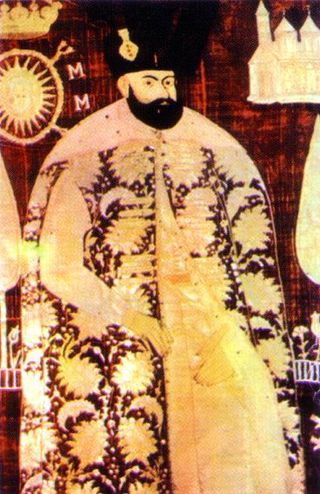
Ieremia Movilă was a Voivode (Prince) of Moldavia between August 1595 and May 1600, and again between September 1600 and July 10, 1606. At the time, Moldavia was a vassal province of the Polish-Lituania CommonWealth.

The House of Basarab was a ruling family of Cuman origin, which had an important role in the establishing of the Principality of Wallachia, giving the country its first line of Princes, one closely related with the Mușatin rulers of Moldavia. Its status as a dynasty is rendered problematic by the official elective system, which implied that male members of the same family, including illegitimate offspring, were chosen to rule by a council of boyars. After the rule of Alexandru I Aldea, the house was split by the conflict between the Dănești and the Drăculești, both of which claimed legitimacy. Several late rulers of the Craiovești claimed direct descent from the House after its eventual demise, including Neagoe Basarab, Matei Basarab, Constantin Șerban, Șerban Cantacuzino, and Constantin Brâncoveanu.
Petru Rareș, sometimes known as Petryła or Peter IV ; c. 1483 – 3 September 1546), was twice voivode of Moldavia: 20 January 1527 to 18 September 1538 and 19 February 1541 to 3 September 1546. He was an illegitimate child born to Stephen the Great. His mother was Maria Răreșoaia of Hârlău, whose existence is not historically documented but who is said to have been the wife of a wealthy boyar fish-merchant nicknamed Rareș "rare-haired". Rareș thus was not Petru's actual name but a nickname of his mother's husband.

The Principality of Transylvania was a semi-independent state ruled primarily by Hungarian princes. Its territory, in addition to the traditional Transylvanian lands, also included the other major component called Partium, which was in some periods comparable in size with Transylvania proper. The establishment of the principality was connected to the Treaty of Speyer. However, Stephen Báthory's status as king of Poland also helped to phase in the name Principality of Transylvania. Although the principality was essentially independent, it existed as an Ottoman vassal state for the majority of the 16th and 17th centuries, overseen by Ottoman Turkish sultans but ruled by Hungarian princes. At various points during this period, the Habsburgs also exerted a degree of suzerainty in the region.

Mircea the Shepherd, was the Voivode of Wallachia three times: January 1545 –16 November 1552; May 1553–28 February 1554 ; and January 1558–21 September 1559.
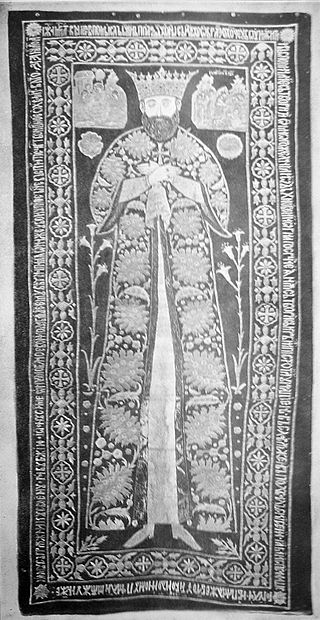
Simion Movilă, a boyar of the Movilești family, was twice Prince of Wallachia and Prince of Moldavia from July 1606 until his death.
Doamna Ecaterina Cercheza was a Circassian noblewoman who became Princess consort of Moldavia by marriage to Vasile Lupu. As reported by Evliya Çelebi, her mother was the sister of Koca Dervish Mehmed Pasha who was the Grand Vizier of the Ottoman Empire from 1653 to 1654, and her sister was married to Islam III Giray, Khan of Crimea (1644–1654). She played a major role on personal and political decisions of her husband and son Ştefăniţă Lupu. Well known for her philanthropic activities, Doamna Ecaterina Cercheza became patron of the Moldavian monasteries and churches. She developed a strong reputation for her diplomatic and negotiating skills in time of crisis, in the absence of her husband and son.
George of Hungary was an Ottoman slave that escaped and reverted from Islam to Christianity, writing afterwards about his experiences. As per his own description, when George was 15 or 16, he was taken prisoner and sold into slavery when the Ottoman Turks invaded the town of Mühlbach in 1438. George had arrived to the city a year earlier, probably to go to a school in the local Dominican monastery.
